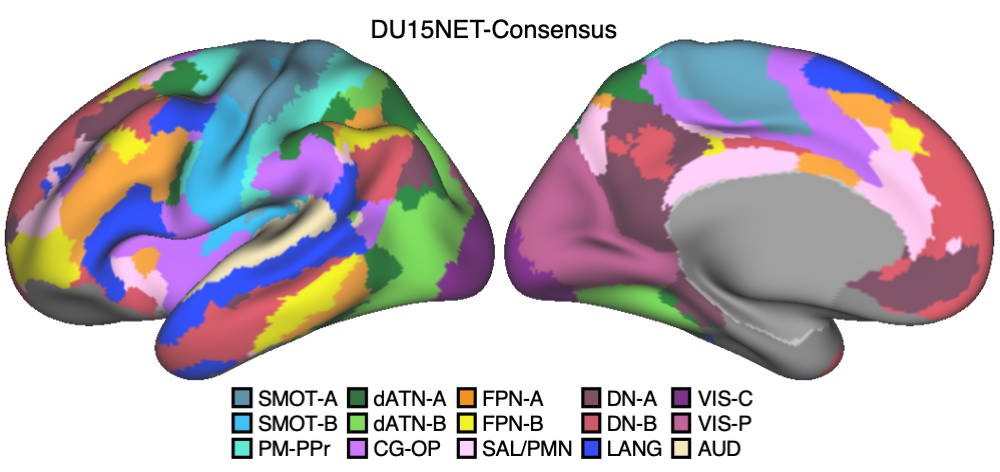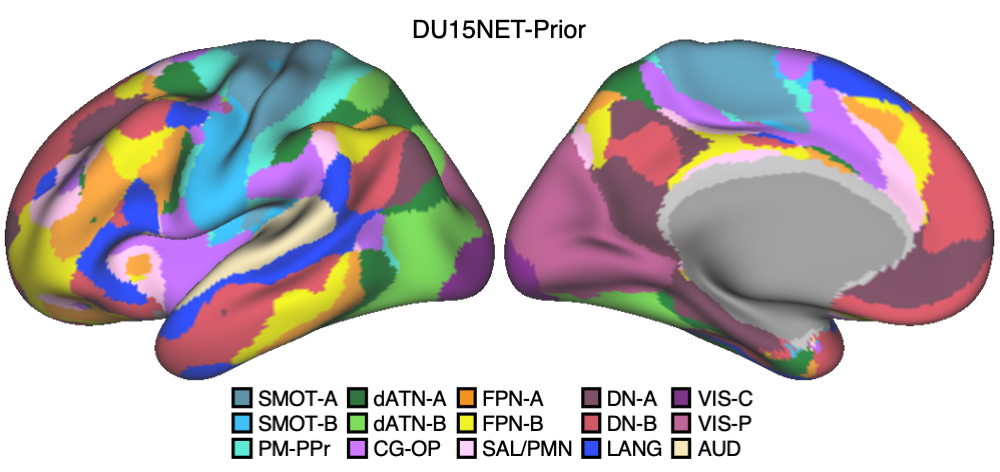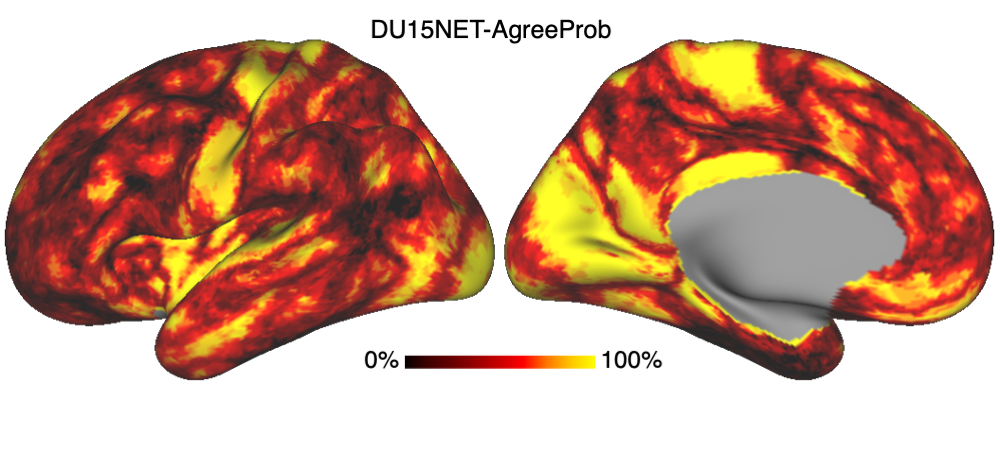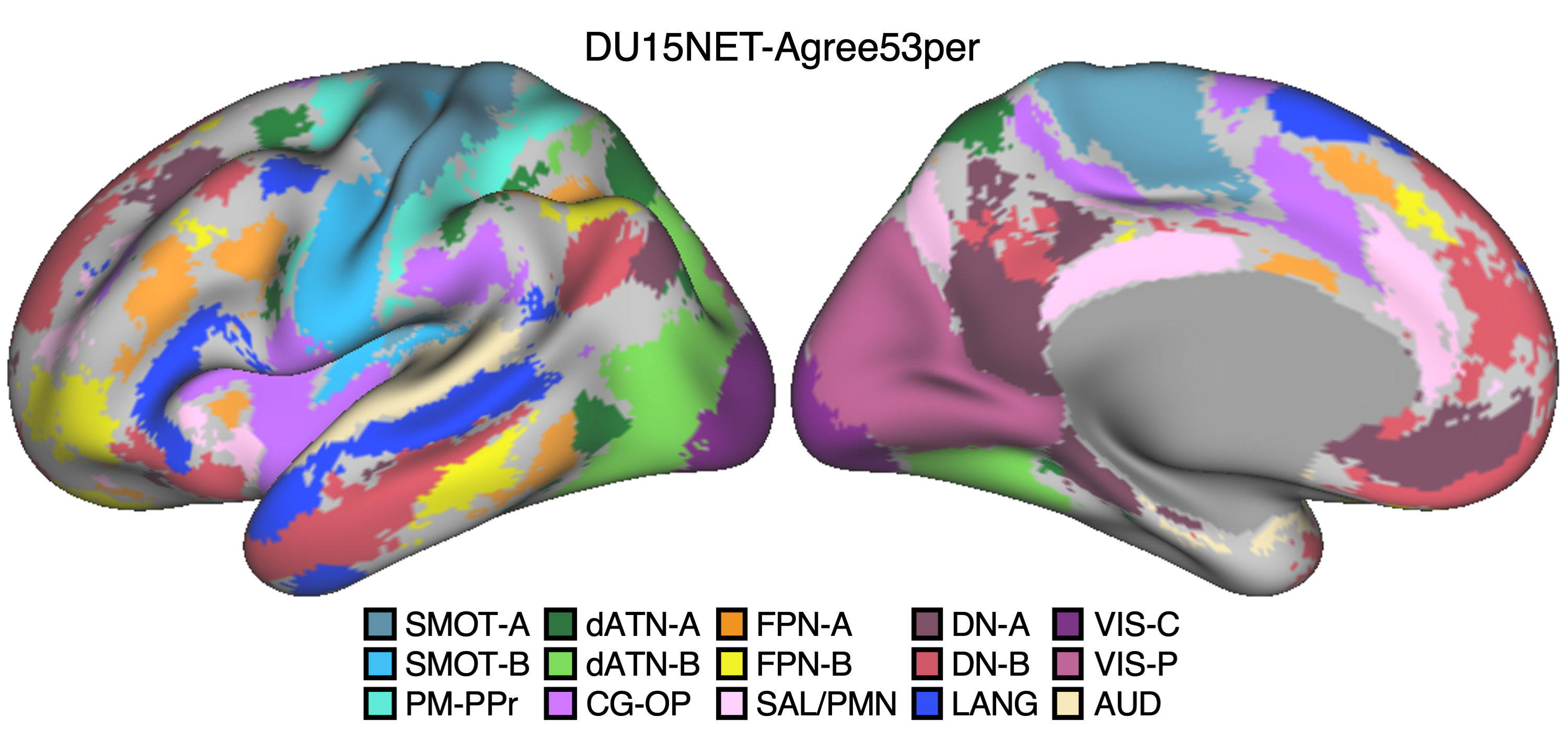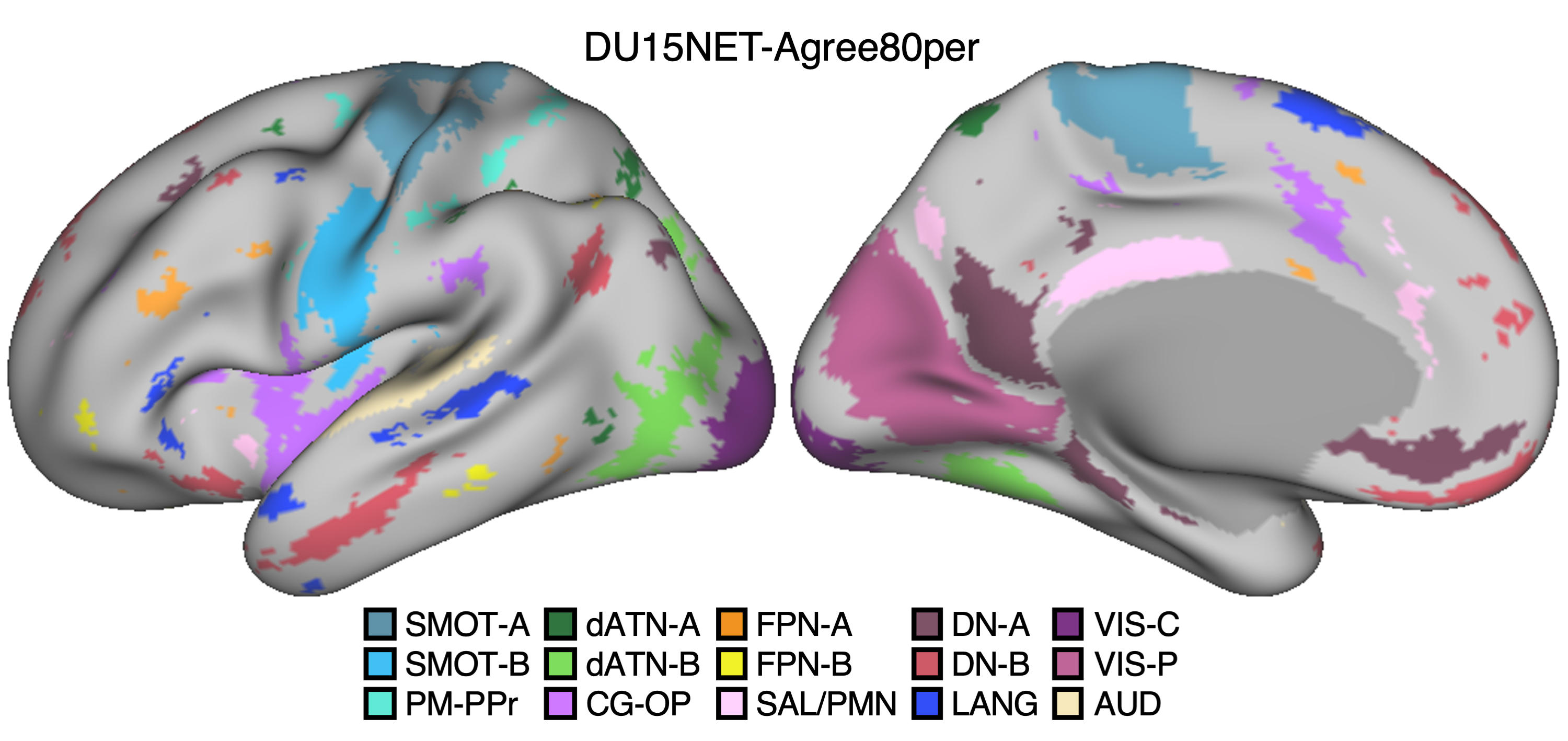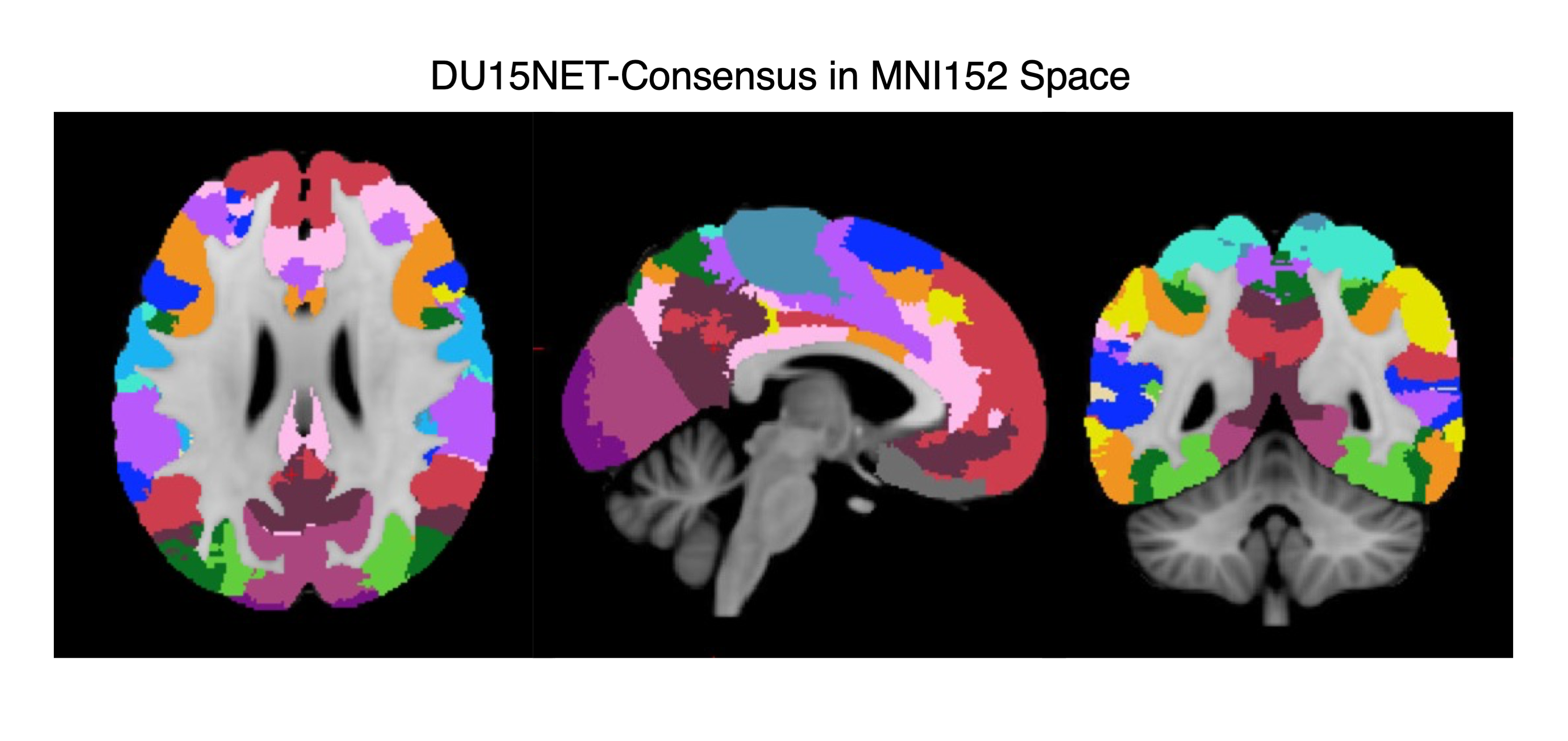A novel 15-network parcellation from fMRI data in 15 intensively sampled participants
A novel 15-network parcellation, named DU15NET, was constructed by estimating networks from functional MRI (fMRI) data in 15 intensively sampled participants. We used the network estimates to better understand individual variation, spatial relations among networks, and their functional properties. The estimates were further used to construct atlases that we provide to the community as open resources. Five example atlases are shown. To use the parcellations, you can just click on this link: XXX. Specifically, there are three subfolders corresponding to three different spaces FreeSurfer, MNI, and HCP. Initially computed in FreeSurfer fsaverage6 space, the parcellations were then sampled to fsaverage5 and fsaverage space. Additionally, they were projected to HCP fslr32k and FSL MNI space, broadening their applicability across various neuroimaging contexts.
References
DU15NET-Consensus: A consensus map represents the assignment at each vertex to the most common network among the 15 individuals collected here. For many purposes, this atlas can function and be utilized in group-based studies as an update to the prior “Yeo2011” atlases with refinements that reflect our current understanding of human cerebral network organization. Given signal dropout near the sinuses and the inner ear, we manually created an uncertain 'network' in the orbitofrontal cortex and adjacent ventrolateral prefrontal cortex (VLPFC), rostral inferior temporal cortex, and the temporal pole, marked as dark grey, we recommend disregarding this 'network' in analyses using this atals. The DU15NET-Consensus atlas differs from the DU15NET-Prior shown below in that it reflects the idiosyncratic features and spatial registrations of the data from the present participants, including small regions that are absent in the group-averaged estimates. For example, there is a clear representation of the SAL / PMN network in the medial prefrontal cortex.
|
DU15NET_ColorLUT.txt is a FreeSurfer readable text file specifying how the 15 networks are named, numbered and colored in Du et al., 2024:
Index
Network Name
Abbreviation
R
G
B
0
NONE
NONE
0
0
0
0
1
Visual Peripheral
VIS-P
170
70
125
0
2
Cingulo-Opercular
CG-OP
184
89
251
0
3
Default Network-B
DN-B
205
61
77
0
4
Somatomotor-B
SMOT-B
27
179
242
0
5
Auditory
AUD
231
215
165
0
6
Premotor-Posterior Parietal Rostral
PM-PPr
66
231
206
0
7
Dorsal Attention-B
dATN-B
98
206
61
0
8
Somatomotor-A
SMOT-A
73
145
175
0
9
Language
LANG
11
47
255
0
10
Frontoparietal Network-B
FPN-B
228
228
0
0
11
Frontoparietal Network-A
FPN-A
240
147
33
0
12
Dorsal Attention-A
dATN-A
10
112
33
0
13
Visual Central
VIS-C
119
17
133
0
14
Salience / Parietal Memory Network
SAL/PMN
254
188
235
0
15
Default Network-A
DN-A
100
49
73
0
DU15NET-Prior: The 15-network group prior used in the MS-HBM model is made available as the DU15NET-Prior atlas. The DU15NET-Prior utilizes the HCP data processed via their standard processing pipelines, and thus has the benefit of being derived from data collected and registered with a commonly used set of pipelines.
|
DU15NET-AgreeProb: The agreement atlas represents the probability at each vertex of the consistent assignment of the same network across individuals within the current 15-participant sample.
|
DU15NET-Agree53: This agreement map is thresholded to leave only vertices with agreement across participants of n ≥ 8 (53%). The agreement atlases may be most useful when the goal is to construct regions-of-interest that have a high probability of being in one network and not another, in situations where it is appropriate to have regions that cover a portion of the cerebral cortex not the cortex in its entirety.
|
DU15NET-Agree80: : This agreement map is thresholded to leave only vertices with agreement across participants of n ≥ 12 (80%).
|
Parcellations in Nonlinear MNI152 Volume Space
DU15NET_MNI152_1mm.nii.gz is a volume parcellation consisting of 15 cortical networks, derived from FreeSurfer fsaverage6 space and projected into MNI152 space. This transformation is to broaden their applicability across various neuroimaging contexts. The cortical ribbon is defined by putting the FSL MNI152 1mm template through recon-all using FreeSurfer.
|
Information about Downloads
In the folder, there are three distinct folders named fsaverage, fsaverage5 and fsaverage6. The fsaverage contains the high-resolution version of the parcellation, while fsaverage6 and fsaverage5 contain lower-resolution versions of the parcellation. The parcellations were computed in fsaverage6 space and sampled to fsaverage5 and fsaverage. Each of these parcels matches up with a network in the 15 network parcellation by Du et al., (2024). It’s important to note that all labels were generated in FreeSurfer version 5.3 and may not fully function optimally in other FreeSurfer versions. The folder structure mirrors that of a preprocessed FreeSurfer subject. In particular, fsaverage/label/, fsaverage5/label/, and fsaverage6/label/ contain all the parcellation and confidence files. For instance, fsaverage/label/lh.XXX_order.annot is the 15 network parcellation on the left hemisphere ordered and colored as per Du et al., (2024).

